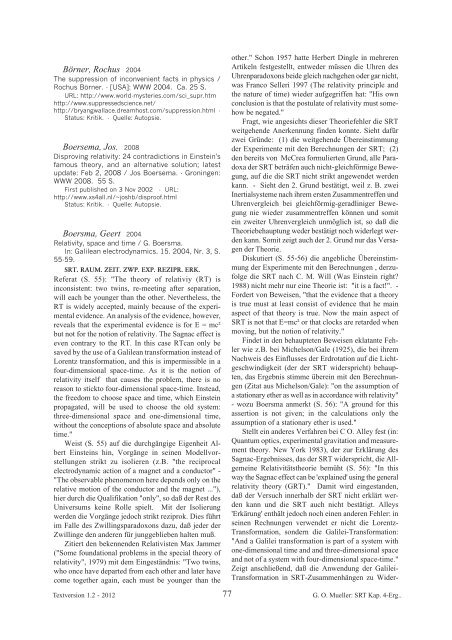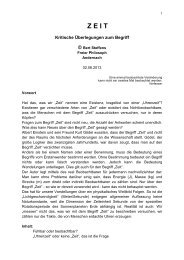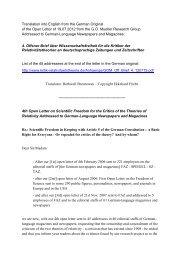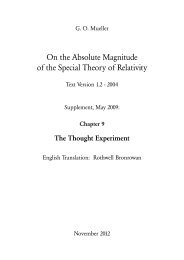2394 weitere kritische Veröffentlichungen - Kritische Stimmen zur ...
2394 weitere kritische Veröffentlichungen - Kritische Stimmen zur ...
2394 weitere kritische Veröffentlichungen - Kritische Stimmen zur ...
Sie wollen auch ein ePaper? Erhöhen Sie die Reichweite Ihrer Titel.
YUMPU macht aus Druck-PDFs automatisch weboptimierte ePaper, die Google liebt.
Börner, Rochus 2004<br />
The suppression of inconvenient facts in physics /<br />
Rochus Börner. - [USA]: WWW 2004. Ca. 25 S.<br />
URL: http://www.world-mysteries.com/sci_supr.htm<br />
http://www.suppressedscience.net/<br />
http://bryangwallace.dreamhost.com/suppression.html -<br />
Status: Kritik. - Quelle: Autopsie.<br />
Boersema, Jos. 2008<br />
Disproving relativity: 24 contradictions in Einstein's<br />
famous theory, and an alternative solution; latest<br />
update: Feb 2, 2008 / Jos Boersema. - Groningen:<br />
WWW 2008. 55 S.<br />
First published on 3 Nov 2002 - URL:<br />
http://www.xs4all.nl/~joshb/disproof.html<br />
Status: Kritik. - Quelle: Autopsie.<br />
Boersma, Geert 2004<br />
Relativity, space and time / G. Boersma.<br />
In: Galilean electrodynamics. 15. 2004, Nr. 3, S.<br />
55-59.<br />
SRT. RAUM. ZEIT. ZWP. EXP. REZIPR. ERK.<br />
Referat (S. 55): "The theory of relativiy (RT) is<br />
inconsistent: two twins, re-meeting after separation,<br />
will each be younger than the other. Nevertheless, the<br />
RT is widely accepted, mainly because of the experimental<br />
evidence. An analysis of the evidence, however,<br />
reveals that the experimental evidence is for E = mc²<br />
but not for the notion of relativity. The Sagnac effect is<br />
even contrary to the RT. In this case RTcan only be<br />
saved by the use of a Galilean transformation instead of<br />
Lorentz transformation, and this is impermissible in a<br />
four-dimensional space-time. As it is the notion of<br />
relativity itself that causes the problem, there is no<br />
reason to stickto four-dimensional space-time. Instead,<br />
the freedom to choose space and time, which Einstein<br />
propagated, will be used to choose the old system:<br />
three-dimensional space and one-dimensional time,<br />
without the conceptions of absolute space and absolute<br />
time."<br />
Weist (S. 55) auf die durchgängige Eigenheit Albert<br />
Einsteins hin, Vorgänge in seinen Modellvorstellungen<br />
strikt zu isolieren (z.B. "the reciprocal<br />
electrodynamic action of a magnet and a conductor" -<br />
"The observable phenomenon here depends only on the<br />
relative motion of the conductor and the magnet ..."),<br />
hier durch die Qualifikation "only", so daß der Rest des<br />
Universums keine Rolle spielt. Mit der Isolierung<br />
werden die Vorgänge jedoch strikt reziprok. Dies führt<br />
im Falle des Zwillingsparadoxons dazu, daß jeder der<br />
Zwillinge den anderen für junggeblieben halten muß.<br />
Zitiert den bekennenden Relativisten Max Jammer<br />
("Some foundational problems in the special theory of<br />
relativity", 1979) mit dem Eingeständnis: "Two twins,<br />
who once have departed from each other and later have<br />
come together again, each must be younger than the<br />
other." Schon 1957 hatte Herbert Dingle in mehreren<br />
Artikeln festgestellt, entweder müssen die Uhren des<br />
Uhrenparadoxons beide gleich nachgehen oder gar nicht,<br />
was Franco Selleri 1997 (The relativity principle and<br />
the nature of time) wieder aufgegriffen hat: "His own<br />
conclusion is that the postulate of relativity must somehow<br />
be negated."<br />
Fragt, wie angesichts dieser Theoriefehler die SRT<br />
weitgehende Anerkennung finden konnte. Sieht dafür<br />
zwei Gründe: (1) die weitgehende Übereinstimmung<br />
der Experimente mit den Berechnungen der SRT; (2)<br />
den bereits von McCrea formulierten Grund, alle Paradoxa<br />
der SRT beträfen auch nicht-gleichförmige Bewegung,<br />
auf die die SRT nicht strikt angewendet werden<br />
kann. - Sieht den 2. Grund bestätigt, weil z. B. zwei<br />
Inertialsysteme nach ihrem ersten Zusammentreffen und<br />
Uhrenvergleich bei gleichförmig-geradliniger Bewegung<br />
nie wieder zusammentreffen können und somit<br />
ein zweiter Uhrenvergleich unmöglich ist, so daß die<br />
Theoriebehauptung weder bestätigt noch widerlegt werden<br />
kann. Somit zeigt auch der 2. Grund nur das Versagen<br />
der Theorie.<br />
Diskutiert (S. 55-56) die angebliche Übereinstimmung<br />
der Experimente mit den Berechnungen , derzufolge<br />
die SRT nach C. M. Will (Was Einstein right?<br />
1988) nicht mehr nur eine Theorie ist: "it is a fact!". -<br />
Fordert von Beweisen, "that the evidence that a theory<br />
is true must at least consist of evidence that he main<br />
aspect of that theory is true. Now the main aspect of<br />
SRT is not that E=mc² or that clocks are retarded when<br />
moving, but the notion of relativity."<br />
Findet in den behaupteten Beweisen eklatante Fehler<br />
wie z.B. bei Michelson/Gale (1925), die bei ihrem<br />
Nachweis des Einflusses der Erdrotation auf die Lichtgeschwindigkeit<br />
(der der SRT widerspricht) behaupten,<br />
das Ergebnis stimme überein mit den Berechnungen<br />
(Zitat aus Michelson/Gale): "on the assumption of<br />
a stationary ether as well as in accordance with relativity"<br />
- wozu Boersma anmerkt (S. 56): "A ground for this<br />
assertion is not given; in the calculations only the<br />
assumption of a stationary ether is used."<br />
Stellt ein anderes Verfahren bei C O. Alley fest (in:<br />
Quantum optics, experimental gravitation and measurement<br />
theory. New York 1983), der <strong>zur</strong> Erklärung des<br />
Sagnac-Ergebnisses, das der SRT widerspricht, die Allgemeine<br />
Relativitätstheorie bemüht (S. 56): "In this<br />
way the Sagnac effect can be 'explained' using the general<br />
relativity theory (GRT)." Damit wird eingestanden,<br />
daß der Versuch innerhalb der SRT nicht erklärt werden<br />
kann und die SRT auch nicht bestätigt. Alleys<br />
'Erkärung' enthält jedoch noch einen anderen Fehler: in<br />
seinen Rechnungen verwendet er nicht die Lorentz-<br />
Transformation, sondern die Galilei-Transformation:<br />
"And a Galilei transformation is part of a system with<br />
one-dimensional time and and three-dimensional space<br />
and not of a system with four-dimensional space-time."<br />
Zeigt anschließend, daß die Anwendung der Galilei-<br />
Transformation in SRT-Zusammenhängen zu Wider-<br />
Textversion 1.2 - 2012 77<br />
G. O. Mueller: SRT Kap. 4-Erg..





